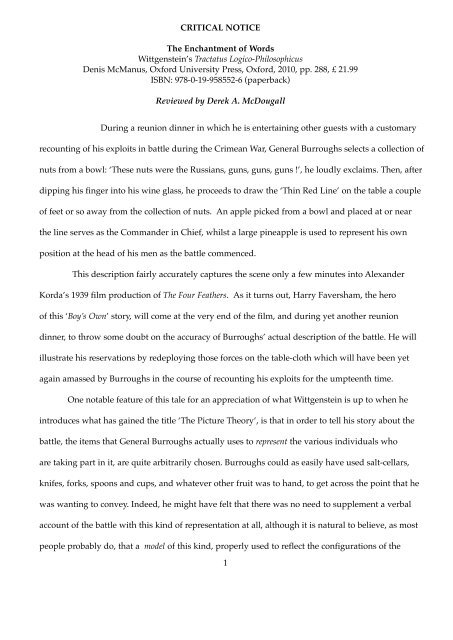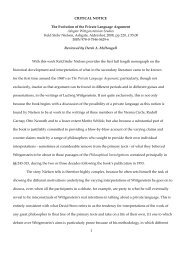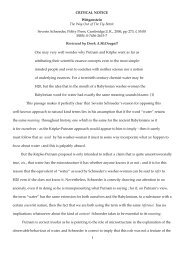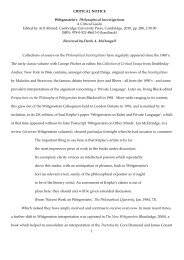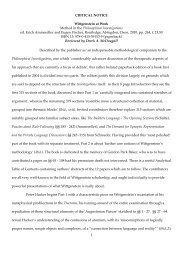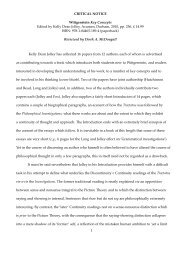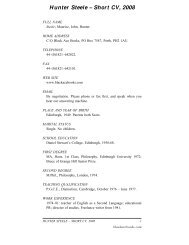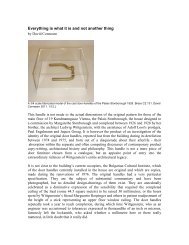CRITICAL NOTICE The Enchantment of Words Wittgenstein's ...
CRITICAL NOTICE The Enchantment of Words Wittgenstein's ...
CRITICAL NOTICE The Enchantment of Words Wittgenstein's ...
Create successful ePaper yourself
Turn your PDF publications into a flip-book with our unique Google optimized e-Paper software.
<strong>CRITICAL</strong> <strong>NOTICE</strong><br />
<strong>The</strong> <strong>Enchantment</strong> <strong>of</strong> <strong>Words</strong><br />
Wittgenstein’s Tractatus Logico-Philosophicus<br />
Denis McManus, Oxford University Press, Oxford, 2010, pp. 288, £ 21.99<br />
ISBN: 978-0-19-958552-6 (paperback)<br />
Reviewed by Derek A. McDougall<br />
During a reunion dinner in which he is entertaining other guests with a customary<br />
recounting <strong>of</strong> his exploits in battle during the Crimean War, General Burroughs selects a collection <strong>of</strong><br />
nuts from a bowl: ‘<strong>The</strong>se nuts were the Russians, guns, guns, guns !’, he loudly exclaims. <strong>The</strong>n, after<br />
dipping his finger into his wine glass, he proceeds to draw the ‘Thin Red Line’ on the table a couple<br />
<strong>of</strong> feet or so away from the collection <strong>of</strong> nuts. An apple picked from a bowl and placed at or near<br />
the line serves as the Commander in Chief, whilst a large pineapple is used to represent his own<br />
position at the head <strong>of</strong> his men as the battle commenced.<br />
This description fairly accurately captures the scene only a few minutes into Alexander<br />
Korda’s 1939 film production <strong>of</strong> <strong>The</strong> Four Feathers. As it turns out, Harry Faversham, the hero<br />
<strong>of</strong> this ‘Boy’s Own’ story, will come at the very end <strong>of</strong> the film, and during yet another reunion<br />
dinner, to throw some doubt on the accuracy <strong>of</strong> Burroughs’ actual description <strong>of</strong> the battle. He will<br />
illustrate his reservations by redeploying those forces on the table-cloth which will have been yet<br />
again amassed by Burroughs in the course <strong>of</strong> recounting his exploits for the umpteenth time.<br />
One notable feature <strong>of</strong> this tale for an appreciation <strong>of</strong> what Wittgenstein is up to when he<br />
introduces what has gained the title ‘<strong>The</strong> Picture <strong>The</strong>ory’, is that in order to tell his story about the<br />
battle, the items that General Burroughs actually uses to represent the various individuals who<br />
are taking part in it, are quite arbitrarily chosen. Burroughs could as easily have used salt-cellars,<br />
knifes, forks, spoons and cups, and whatever other fruit was to hand, to get across the point that he<br />
was wanting to convey. Indeed, he might have felt that there was no need to supplement a verbal<br />
account <strong>of</strong> the battle with this kind <strong>of</strong> representation at all, although it is natural to believe, as most<br />
people probably do, that a model <strong>of</strong> this kind, properly used to reflect the configurations <strong>of</strong> the<br />
1
participants in this kind <strong>of</strong> complex moving scena, can more accurately explain what really occurred.<br />
Another important feature <strong>of</strong> this story, and one which directly relates it to the ‘picture<br />
analogy’ referred to by Denis McManus in the fifth Chapter <strong>of</strong> his book, is that the items used to<br />
represent the various participants in the battle, in order to fulfil their roles, do not have in any way<br />
to resemble the actual individuals who took part in it. Yet as McManus reminds us, Wittgenstein<br />
reported that this picture analogy came to him (Ibid., 66) when he read about how a Parisian car<br />
crash was represented in the courtroom by way <strong>of</strong> a model in which toy cars and dolls stood for<br />
the victims <strong>of</strong> the accident. So it would seem that the physical resemblance between the reality and<br />
the model must have been instrumental in awaking him to the possibility that this notion <strong>of</strong> a Picture<br />
might have an important role to play in his considerations. Indeed, the very idea <strong>of</strong> a ‘fit’ between<br />
the toy cars, the pedestrians and their ‘real’ counterparts, would appear to lie at the centre <strong>of</strong> what<br />
the ‘Picture <strong>The</strong>ory’ is all about. <strong>The</strong> isomorphism between the elements <strong>of</strong> the Picture, and the<br />
elements <strong>of</strong> the ‘real’ accident, is primarily what strikes us when we think about and go on to reflect<br />
more deeply upon those more traditional accounts provided by mostly earlier commentators on the<br />
Tractatus, <strong>of</strong> what must have struck Wittgenstein when he considered this courtroom confrontation.<br />
Yet no matter how tempted we may be to say that what makes this picture, say, <strong>of</strong><br />
Edinburgh Castle a picture <strong>of</strong> Edinburgh Castle, is that it so resembles Edinburgh Castle that it can<br />
hardly pretend to be a picture <strong>of</strong> anything else, this neglects what has now become the familiar<br />
point that it is only within an established convention in which resemblance is used as a means <strong>of</strong><br />
representation that it can perform its picturing role. As the character <strong>of</strong> General Burroughs shows<br />
with the casual adoption <strong>of</strong> his battlefield model, this kind <strong>of</strong> model does not, in order to fulfil its<br />
function, have to employ the usual arrangements <strong>of</strong> miniature soldiers which commonly illustrate<br />
historic scenes <strong>of</strong> battle. In the same way, if we were to ask an artist to draw for us a picture <strong>of</strong><br />
Edinburgh Castle without our knowing that he dabbled in abstract art, he may feel that he had more<br />
than adequately fulfilled our expectations by presenting us with what in our eyes might look like a<br />
monstrosity precisely because it bore no resemblance to Edinburgh Castle whatsoever.<br />
2
<strong>The</strong> central point that Dennis McManus wishes to draw from similar considerations<br />
to these is that what at first sight might have the appearance <strong>of</strong> a powerful explanation <strong>of</strong> the<br />
‘fit’ between language and world, a Picture <strong>The</strong>ory that reveals the ‘internal relation’ between<br />
the method <strong>of</strong> depiction and the reality it serves to depict, can be shown to rest on a confusion.<br />
As the General Burroughs example reveals, and as McManus illustrates with his dining-table<br />
display employing cups, napkins and a pepper-pot to represent the cars, roads and pedestrian<br />
called ‘Frank’ <strong>of</strong> his own road accident, the model used to illustrate the scene gains its sense<br />
not because it intrinsically carries this meaning along with it, but because it is chosen for a<br />
particular purpose solely as a means <strong>of</strong> more clearly representing certain events which actually<br />
took place:<br />
What the picture analogy serves to remind us <strong>of</strong> here is that<br />
our signs have as much life as our use <strong>of</strong> them gives them.<br />
But when the elements <strong>of</strong> our representation are familiar<br />
words or elements which, as in conventional, non-abstract<br />
pictures, have some visual similarity to what they represent,<br />
it is easier to fall into thinking <strong>of</strong> such elements as possessing<br />
a life <strong>of</strong> their own, as it were. (Ibid., 69).<br />
This apparent ‘life <strong>of</strong> their own’ is what on McManus’s view, leads the philosopher in<br />
us to mistakenly think that words have an application independently <strong>of</strong> the use we make <strong>of</strong> them.<br />
Drawing on his example <strong>of</strong> a pepper-pot being drawn across a napkin as a way <strong>of</strong> representing<br />
Frank crossing the road, the philosopher on his view is led to believe that the pepper-pot has<br />
‘possibilities’ which mirror Frank’s, to the extent that it becomes for him unthinkable that these<br />
items should lose the ‘forms’ in virtue <strong>of</strong> which this mirroring holds without ceasing to be the<br />
items that they are, items which are in this way ‘internally related’ to each other. But this kind<br />
<strong>of</strong> ‘internal relation’ is a sham, because what sense it has depends, as has been amply illustrated,<br />
on having already made a decision about how to use the pepper-pot and napkins as a means <strong>of</strong><br />
3
epresenting these items and the roles they play within the model:<br />
<strong>The</strong> root confusion that creates the illusion <strong>of</strong> a necessary, substantial<br />
isomorphism is that, when we contemplate Frank standing in the road<br />
and the pepper-pot standing on the napkin, we are not contemplating<br />
bases which may yet allow a correlation between the two to emerge,<br />
but rather two products <strong>of</strong> a method <strong>of</strong> correlation, <strong>of</strong> projection; in<br />
this case it is spatial location..............When we see object and name<br />
matching in form, what we see before us is not something which will<br />
allow the two to be correlated, but rather the output <strong>of</strong> a correlation that<br />
has already been enacted (Ibid., 95).<br />
This correlation ‘between word and world’ is what General Burroughs succeeds in enacting<br />
when he uses the items on the dinner-table for his immediate purposes to represent the soldiers<br />
and guns in his Crimean reminiscences, or when McManus uses the pepper-pot and the napkin<br />
to explain the factors that caused his road accident to occur. This point is hammered home<br />
throughout Chapter 7 <strong>of</strong> the book, where he reiterates that the metaphysical notion <strong>of</strong> a ‘fit’ is a<br />
myth because there can be no ‘facts <strong>of</strong> correspondence’ prior to the use that is made <strong>of</strong> the picture<br />
to represent for a particular purpose what the facts actually are (Ibid.,98); just as there is no<br />
requirement that the world imposes upon language in some proposed metaphysical sense,<br />
independently <strong>of</strong> the ordinary uses that we make <strong>of</strong> our terms when we correctly describe<br />
the General’s battle or what took place to cause the accident to occur (Ibid., 99).<br />
On this view, anyone who takes seriously the idea which we imagine must have motivated<br />
Wittgenstein when he was struck by the story about the Parisian car accident, viz., that it brought<br />
home to him the notion that there is an isomorphism or ‘fit’ between the reality and the model<br />
in which this reality is represented, will be giving full reign to a tendency which all the examples<br />
used so far have shown to be mistaken. From this new perspective, one that we can readily see<br />
that Wittgenstein adopted in the Philosophical Investigations, the requirement for a ‘fit’ between<br />
4
word and world reflects only the confused need to tell a metaphysical story about an isomorphism<br />
between a reality depicted and a method <strong>of</strong> depiction, that has no useful role to play.<br />
<strong>The</strong> more difficult question which then naturally arises is whether Wittgenstein can be seen<br />
to have been guilty himself <strong>of</strong> accepting this story when he wrote the Tractatus. On a certain very<br />
traditional account <strong>of</strong> that work he certainly was, although it can also provisionally appear from<br />
McManus’s examples that he was always too farsighted a philosopher to have given in to tendencies<br />
which have been shown to be misguided. Far from its being the case that Wittgenstein adhered to<br />
some form <strong>of</strong> Picture <strong>The</strong>ory in the Tractatus, he was according to McManus actually attempting to<br />
undermine the very tendencies that the road accident model is usually assumed to illustrate. <strong>The</strong><br />
appeal <strong>of</strong> the courtroom model could not then have consisted for him in its telling us any kind <strong>of</strong><br />
metaphysical story involving a dichotomy between a reality depicted and a method <strong>of</strong> depiction:<br />
When he leads us to certain ‘internal properties’ and ‘internal relations’,<br />
he is not articulating perplexing answers to certain difficult questions,<br />
but indicating situations in which we face things that look like ‘questions’<br />
but which we do not really understand. Thus those supposed ‘answers’,<br />
Wittgenstein’s ‘propositions’, can be seen as ‘rungs’ <strong>of</strong> a ‘ladder’ to be<br />
‘climbed’ and then ‘thrown away’ (Ibid., 100).<br />
This concise expression <strong>of</strong> what has come to be known as a resolute approach to the<br />
Tractatus is repeated two pages further on, at the beginning <strong>of</strong> Chapter 8 on ‘Subjectivity’, where<br />
he claims explicitly that Wittgenstein’s strategy is to ‘think through a con-formist conception <strong>of</strong><br />
the relationship between thinker and world; the internal relations he identifies show once again<br />
how such a conception would have to work, but serve ultimately to indicate how that conception<br />
rests on a confusion’ (Ibid., 102). To some readers, however, McManus may seem to make things<br />
rather too easy for himself at the beginning <strong>of</strong> his Chapter 5 on ‘<strong>The</strong> Picture Analogy’ by claiming,<br />
after quoting Tractatus 2.1 and 4.01, that a Picture <strong>The</strong>ory ‘is not very appealing’ (Ibid., 65). For<br />
those who may already be puzzled by how language represents, he questions firstly how alike<br />
5
linguistic and pictorial representation are in any event, and secondly how pictorial representation<br />
is supposed to work. Indeed, this form <strong>of</strong> representation on his view faces problems which parallel<br />
those concerning linguistic representation, with the consequence that Wittgenstein ‘may seem to be<br />
seeking to assimilate one problematic form <strong>of</strong> representation to another’:<br />
Ascribing a ‘picture theory’ <strong>of</strong> representation to the Tractatus is, I believe,<br />
a mistake anyway. My view is that Wittgenstein uses the analogy between<br />
pictures and propositions not as part <strong>of</strong> an explanation <strong>of</strong> how meaning or<br />
thought is possible, but rather in questioning whether we have assigned<br />
sense to that very ‘possibility’, whether we really understand what it is that<br />
we think needs to be ‘accounted for’ here, the supposed philosophical problem<br />
that needs to be ‘solved’ (Ibid., 65).<br />
Remarking that what is so striking about the Paris courtroom representation is that it<br />
is ‘not what most people would immediately think <strong>of</strong> as an example <strong>of</strong> a picture’ (Ibid., 66), it<br />
would appear that McManus has no sympathy whatsoever for the thought that reading about<br />
the car crash and how it came to be reflected in a courtroom model might after all have struck<br />
Wittgenstein at the time as a revelation, because it provided a ‘concrete’ example <strong>of</strong> an abstract<br />
idea. Even if the model might never have been able to wholly capture his intentions, it may<br />
nevertheless have formed an approximation which came close to reflecting what he wanted to<br />
say, for example, about analysing ordinary propositions into elementary propositions. McManus<br />
then quotes what on the face <strong>of</strong> it is a very revealing passage from the Tractatus:<br />
<strong>The</strong> essential nature <strong>of</strong> the propositional sign becomes very clear<br />
when we imagine it made up <strong>of</strong> spatial objects (such as tables,<br />
chairs, books) instead <strong>of</strong> written signs.<br />
<strong>The</strong> mutual spatial relation <strong>of</strong> these things then expresses the sense<br />
<strong>of</strong> the proposition ( 3.1431).<br />
Yet the most that McManus can say in response to what would appear to be a pretty clear<br />
6
endorsement <strong>of</strong> the claim that the idea <strong>of</strong> a proposition as a picture is playing an important role in<br />
his thinking, is that the ‘model envisaged here is even less “picture-like” in that its “elements” are<br />
physically or visually dissimilar to what they are to represent’ (Ibid.). It would seem that he has<br />
already from the beginning <strong>of</strong> his presentation stacked his cards against the idea that Wittgenstein<br />
could really have been endorsing a metaphysical viewpoint in 3.1431. <strong>The</strong> view he wishes to expound<br />
instead is that whilst on a first reading <strong>of</strong> the Tractatus it appears that names and propositions are<br />
‘internally related’, as a way <strong>of</strong> explaining how the ‘logical/illogical’ boundary manages to lie where<br />
it does, a proper appreciation <strong>of</strong> the import <strong>of</strong> 6.54 will reveal to us that whilst there is indeed<br />
‘no sense to the notion <strong>of</strong> first grasping what a name represents and then learning how that name<br />
relates to the propositions in which it figures’ (Ibid., 73), the picture analogy ultimately shows that<br />
to have identified a name understood as a symbol and not as a sign is already to know how it figures<br />
in propositions. Consequently, the philosophical question how names combine to form propositions,<br />
depends on confusing sign & symbol . That names and propositions are internally related, therefore,<br />
is a pseudo-answer to a pseudo-question. Wittgenstein in the Tractatus is undermining these spurious<br />
problems from within through the employment <strong>of</strong> a startlingly new modus operandi.<br />
Yet when we study the considerations that weigh with McManus when discussing his roadaccident,<br />
he may appear to some readers to be availing himself <strong>of</strong> notions which are not obviously<br />
central to the philosophy <strong>of</strong> the Tractatus at all. <strong>The</strong> use <strong>of</strong> his pepper-pot and napkins, for example,<br />
like the reaction that he believes that most <strong>of</strong> us would have to the claim that ‘this is Frank’ followed<br />
by nothing at all (Ibid., 67), where the role <strong>of</strong> the sign ‘Frank’ as a symbol in an ordinary proposition, is<br />
not explained in the manner <strong>of</strong> General Burroughs, are ideas which find their proper home only in the<br />
Philosophical Investigations. But can McManus really be doing no more than leaving himself open to a<br />
charge, <strong>of</strong>ten made against resolute readings, that in objecting to a certain metaphysical notion <strong>of</strong><br />
picturing, and in claiming that ‘our signs have as much life as our use <strong>of</strong> them gives them’ (Ibid., 69)<br />
he is reading into the earlier writings ideas which find their proper home only in Wittgenstein’s later<br />
work This issue is naturally quite separate from that <strong>of</strong> the validity <strong>of</strong> those ideas in their own right.<br />
7
It may be that the important question is not whether this charge can be made to stick,<br />
because on this point it may be surmised that the argument at this point can go either way depending<br />
on one’s initial predilections. <strong>The</strong> fact that McManus appears to be appealing to certain features usually<br />
found only in the later philosophy does not in itself show that they cannot find their expression in some<br />
form in the earlier philosophy as well. Furthermore, if a philosopher is committed to a resolute view,<br />
derived, say, from a textual study <strong>of</strong> the book itself, according to an approach which is text-immanent<br />
in Alois Pichler’s sense (1), this may make him less tempted to regard as even relevant certain external<br />
historical facts relating to what was said by Wittgenstein during the 1930’s, which could be gathered as<br />
evidence in favour <strong>of</strong> the claim that he was then in the course <strong>of</strong> repudiating a metaphysical viewpoint<br />
to which he had earlier adhered. Why, it may even be suggested, should he have the last word on the<br />
fundamental significance <strong>of</strong> what he wrote in the Tractatus, when at the point <strong>of</strong> writing he may not<br />
have been at all certain <strong>of</strong> the true nature <strong>of</strong> the vision which his genius had revealed to him<br />
Whilst considerations <strong>of</strong> this kind are hardly conclusive, they can help to explain why the debate<br />
at this point sometimes has the appearance in the literature <strong>of</strong> going round in a circle, suggesting that<br />
in the final reckoning there may be no acceptable criteria for adjudicating between these outlooks, since<br />
they depend on the presuppositions that each side brings to the debate. Here, however, McManus may<br />
be able to come to our aid when he raises the question in an interesting ‘Appendix A’ why there is a<br />
Later Wittgenstein at all, a question to which he cannot understandably be seen to be providing the<br />
conventional answer that the Tractatus advocated what he calls a kind <strong>of</strong> con-formism which Wittgenstein<br />
later recognised to be mistaken (Ibid., 235):<br />
One <strong>of</strong> the main reasons why I came to have doubts initially about the<br />
notion that the Tractatus <strong>of</strong>fers us an explanation <strong>of</strong> the possibility <strong>of</strong><br />
meaning that rests on some kind <strong>of</strong> ineffable metaphysics was my reading<br />
Wittgenstein’s transitional works and failing to find there the kind <strong>of</strong><br />
critical revisions that his having advocated such a view earlier would<br />
lead one to expect. (Ibid.)<br />
8
<strong>The</strong>re is on McManus’s assessment no working out <strong>of</strong> a new metaphysical outlook in<br />
these transitional writings, presumably because there is no older one to be rejected, and no criticism<br />
either <strong>of</strong> an ineffable metaphysics for the same reason. McManus also claims that what criticisms <strong>of</strong><br />
con-formism one does find are not criticisms <strong>of</strong> Wittgenstein’s former self, presumably because he<br />
did not in the Tractatus actually hold this con-formist point <strong>of</strong> view.<br />
What McManus does discover, however, is a criticism by the later Wittgenstein <strong>of</strong> the<br />
earlier in terms <strong>of</strong> his early adherence to an all-encompassing conception <strong>of</strong> language, a conception<br />
mentioned in § 65 <strong>of</strong> the Investigations, with its reference to the general form <strong>of</strong> propositions and <strong>of</strong><br />
language. <strong>The</strong> new conception <strong>of</strong> language which replaces the old one, and its relation to the<br />
notion <strong>of</strong> family resemblance, capturing the principle that there is no one thing that we can call a<br />
‘proposition’, have consequences which are uncontroversially regarded by McManus both as wideranging<br />
and also as fundamental to the kinds <strong>of</strong> changes that took place later on in Wittgenstein’s<br />
conception <strong>of</strong> philosophical problems (Ibid., 240).<br />
Readers will find, then, that McManus’s discussion in the following sections concerning<br />
those changes and developments in Wittgenstein’s philosophical outlook, contain a great deal that<br />
is common ground between those like himself who aspire to a resolute approach and those who<br />
in a more traditional way see a change from the overtly metaphysical to the anthropocentric: his<br />
treatment <strong>of</strong> sections §§ 90 - 91, § 23, and § 121, for example, contain much that might form part <strong>of</strong><br />
a standard ‘textbook’ treatment <strong>of</strong> the speaking <strong>of</strong> language as a reflection <strong>of</strong> participation in ways<br />
<strong>of</strong> living, forms <strong>of</strong> life; and whilst he does find the reorientation in Wittgenstein’s thinking ‘radical<br />
and difficult to appreciate’ (Ibid., 253), this does not prevent McManus from seeing Wittgenstein’s<br />
refusal to become involved in spurious debates about the discovery <strong>of</strong> the defining characteristic<br />
shared by all the problems <strong>of</strong> philosophy, as a component <strong>of</strong> a ‘true later radicalism’ which is to be<br />
sharply distinguished from Wittgenstein’s earlier metaphilosophical vision in the Tractatus. McManus<br />
is evidently complaining here about the dogmatic outlook which characterised a Wittgenstein who<br />
in the Preface to the Tractatus claimed that its ‘definitive’ and ‘unassailable’ truths provide the final<br />
9
solution to the problems <strong>of</strong> philosophy. This explains his reference to Wittgenstein as someone<br />
who earlier on articulated a certain vision <strong>of</strong> philosophy: that <strong>of</strong> ‘Philosophy-capital-P articulated<br />
in terms <strong>of</strong> Analysis-capital-A and the Arbitrariness-capital-A <strong>of</strong> Grammar-capital-G, all <strong>of</strong> which<br />
are underpinned by a vision <strong>of</strong> Language-capital-L’ (Ibid., 254).<br />
This quotation immediately precedes the final question he will ask in his book, why<br />
the Tractatus is still worth reading if its value as a work <strong>of</strong> philosophy is compromised by the<br />
shortcomings which, via his account <strong>of</strong> the change in Wittgenstein’s ideas which culminated in<br />
the Investigations, he has just being using his Appendix to unravel. Repeating the not uncommon<br />
charge already made here against resolute readings <strong>of</strong> the Tractatus, that they make philosophy less<br />
interesting because they assimilate the early Wittgenstein to the later, he understandably replies that<br />
this charge depends on the assumption, which he has throughout his book attempted to repudiate,<br />
that the only thing that could make the Tractatus interesting on this view is its advocacy <strong>of</strong> an<br />
ineffable metaphysics and a picture theory <strong>of</strong> representation. Believing that there is a lasting value<br />
in at least one aspect <strong>of</strong> the early Wittgenstein’s work that the later work lacks, he then makes a<br />
claim that is bound to startle those wedded to the Tractatus as a work <strong>of</strong> metaphysics :<br />
Many <strong>of</strong> the critical insights that this Appendix discusses ought<br />
perhaps to have been anticipated by the author <strong>of</strong> the Tractatus:<br />
to fail to recognise ‘family resemblance’ concepts is to display a<br />
faith in ‘surface grammar’ as a guide to our intent in using words,<br />
a presumption that where we have the same sign, we have the<br />
same symbol (Ibid., 255)<br />
For those already wedded to a more traditional account <strong>of</strong> Wittgenstein’s intentions in<br />
the Tractatus, this will appear to be no more than a begging <strong>of</strong> the question based on the very charge<br />
<strong>of</strong> assimilating the early Wittgenstein to the later that he has already attempted to undermine. One<br />
only needs to study the outlook on the Tractatus expressed, for example, by Severin Schroeder in<br />
Wittgenstein <strong>The</strong> Way Out <strong>of</strong> the Flybottle (Polity 2006), a book published in the same year as the<br />
10
original hardback version <strong>of</strong> his own, to appreciate the yawning gulf between two approaches<br />
between which it is difficult to see that there could be any kind <strong>of</strong> accommodation. McManus<br />
nevertheless wishes to regard the Tractatus as having presented, despite its shortcomings, a vision<br />
<strong>of</strong> philosophy as a misguided exploration <strong>of</strong> the supposed basis <strong>of</strong> ‘intelligibility’ made possible<br />
only by sign/symbol confusion, that is more vivid than that provided in the later philosophy,<br />
(Ibid., 256) even if the later Wittgenstein provides a ‘richer’ exploration <strong>of</strong> how and why we<br />
succumb to philosophical confusion (Ibid., 255).<br />
<strong>The</strong> final chapter <strong>of</strong> the book prior to his Appendix A explores the fate <strong>of</strong> four<br />
‘keys’ to the Tractatus that McManus has identified at the beginning, ‘the point’ <strong>of</strong> the book, its<br />
‘whole meaning’, its author’s ‘fundamental thought’ and his ‘main contention’. Here McManus<br />
again emphasises that the ‘discovery’ <strong>of</strong> an internal relation as a reflection <strong>of</strong> what is shown,<br />
e.g., a proposition as ‘showing’ its sense, disintegrates because the desire which cannot be fulfilled<br />
for a certain kind <strong>of</strong> explanation points towards the conclusion that this desire itself rests on a<br />
confusion. What, for example, sounds like an explanation <strong>of</strong> how names can be combined to<br />
form propositions, viz., that names and propositions are internally related, collapses because<br />
posing the question already presupposes its everyday ‘answer’.<br />
This ground has already been covered earlier in the book, so that McManus’s<br />
‘Conclusion’ Chapter 15 is in some measure a summing-up <strong>of</strong> material much <strong>of</strong> which has already<br />
been explored in Chapter 7, ‘<strong>The</strong> “Con-formity” <strong>of</strong> Language and World’. Once again McManus<br />
draws our attention to the internal relation <strong>of</strong> depicting which appears as if it could explain how<br />
propositions can represent reality, when the form <strong>of</strong> isomorphism envisaged provides not the<br />
grounds for a comparison, but rather presupposes that the relation between the means <strong>of</strong> depiction<br />
and what is depicted is already the product <strong>of</strong> a method <strong>of</strong> comparison. In much the same way,<br />
the General’s decision to employ the apple, pineapple and nuts as a way <strong>of</strong> representing various<br />
participants in his story is just his way <strong>of</strong> deciding their roles in the model which he is using in<br />
order to clarify what went on in the battle:<br />
11
As I argued..., a sign/symbol confusion can be seen behind<br />
the con-formist story. No one thinks that one might discover<br />
rules for the use <strong>of</strong> signs, since ‘the sign is arbitrary’...But also,<br />
no one thinks that one might discover rules for the use <strong>of</strong> symbols,<br />
since when considered as symbols, we take for granted how the<br />
words in question ought to be used; that cannot be seen as a matter<br />
to be determined. Rather, the illusion <strong>of</strong> con-formity, <strong>of</strong> a determination<br />
<strong>of</strong> how words must be used to describe the world, arises when we<br />
treat words simultaneously as signs and symbols (Ibid., 221).<br />
This is another echo <strong>of</strong> the fundamental misperception, mentioned at the very beginning<br />
<strong>of</strong> his book, with which he is ultimately concerned, the confused temptation to endow words<br />
with a life <strong>of</strong> their own, independently <strong>of</strong> the use we make <strong>of</strong> them, so that we enchant and<br />
become enchanted by them, especially when doing philosophy (Ibid., 1). It is a significant feature<br />
<strong>of</strong> McManus’s approach here that he sees Wittgenstein uprooting this confusion between sign<br />
and symbol and the role it plays in the philosophical notion <strong>of</strong> an internal relation, even in cases<br />
where Wittgenstein might be thought to be clearly outlining a metaphysical proposal:<br />
On a larger scale, the manner in which the picture analogy<br />
itself works might be compared with the modus operandi <strong>of</strong><br />
this ‘notational’ solution: both undermine philosophical<br />
illusions by ‘disenchanting’ words. By asking us to think<br />
about models that are ‘made up <strong>of</strong> spatial objects (such as<br />
tables, chairs, books) instead <strong>of</strong> written signs’ (3.1431),<br />
Wittgenstein breaks up the familiar sign/symbol associations<br />
upon which our philosophical confusions feed.(Ibid., 222).<br />
In the course, therefore, <strong>of</strong> releasing us from the temptation to think that his pepper-pot<br />
and napkin, for example, could retain their meanings independently <strong>of</strong> ‘the particular systems<br />
12
<strong>of</strong> representation in which they figure’ (Ibid.), McManus uses as an example 3.1431, which many<br />
more traditional commentators would be inclined to regard as an expression <strong>of</strong> the very antithesis<br />
<strong>of</strong> what he is suggesting. In these circumstances, the possibility <strong>of</strong> some form <strong>of</strong> accommodation<br />
between these opposing perspectives seems highly unlikely.<br />
<strong>The</strong>re is a brief treatment in the next section <strong>of</strong> ‘the mystical’ which ‘shows itself’ (6.522),<br />
and McManus suggests that Wittgenstein, ever down-to-earth in his approach to matters <strong>of</strong> this<br />
kind, is not concerned with anything mysterious or supernatural, but instead with a mismatch<br />
between the difficulties <strong>of</strong> ordinary life and the resources and mind-set <strong>of</strong> philosophy:<br />
<strong>The</strong> mundane ethical demands <strong>of</strong> ordinary life, <strong>of</strong> being straight<br />
with other people and with oneself, are obscured by the demand<br />
that we make ourselves receptive to mystical insight; such a notion<br />
encourages us to look in the wrong place for what is difficult about<br />
‘doing the right thing’. But a step towards recognising that ordinary<br />
life that we already know, recognising it having been in the grip <strong>of</strong><br />
philosophical fantasy, is a confrontation with what that fantasy can<br />
understand only as ‘the mystical’ (Ibid., 223).<br />
What McManus is saying here, however, following his initial remark that what is<br />
actually meant by the mystical in the Tractatus is unclear, can surely have very little to do with<br />
what is being expressed in 6.44, 6.45 and 6.522, It derives, in fact, from comments by Englemann<br />
who clearly understood Wittgenstein to be someone who in his daily life would have no truck<br />
with any ‘transcendental twaddle’ (Ibid.). In the Tractatus, on the other hand, the concentration<br />
is almost entirely on a kind <strong>of</strong> puzzlement that might arise from reflection on the thought that<br />
anything should exist at all, a characteristically ‘metaphysical’ insight that in other circumstances<br />
we might imagine Wittgenstein questioning as having no useful role, yet one which is repeated in<br />
the Lecture on Ethics where ‘wonder at the existence <strong>of</strong> the world’ is regarded as one <strong>of</strong> his ‘ethical<br />
experiences par excellence’ (As quoted, Ibid.). This leads McManus to conclude that Wittgenstein’s<br />
13
emarks on the ethical may help us understand what he says about the mystical. Yet McManus’s<br />
account <strong>of</strong> ethics in Chapter 13, ‘Ethics and “the Inexpressible”‘ and in Chapter 14, ‘Ethics and<br />
“the Ladder”’ contains some <strong>of</strong> the most difficult material in the book, sometimes difficult in its<br />
own right and sometimes difficult because it is hard to see how it relates to Wittgenstein. This<br />
justifies his initial remarks before launching his account:<br />
<strong>The</strong> evidence upon which any commentator can draw in trying to<br />
make sense <strong>of</strong> Wittgenstein’s comments on ethics is sparse. <strong>The</strong>se<br />
comments are few and far between; this is one <strong>of</strong> the reasons why<br />
they are so puzzling - they seem to come out <strong>of</strong> nowhere - and are<br />
so easy for commentators to disregard. As a result <strong>of</strong> this insubstantial<br />
basis, any reading <strong>of</strong> Wittgenstein’s remarks on ethics will be speculative;<br />
and anyone unable to entertain such a reading will simply have to suspend<br />
judgement on what these remarks mean (Ibid., 177).<br />
Yet this precedes an account in which the ‘inexpressibility’ <strong>of</strong> ethics is related to the<br />
notions <strong>of</strong> decency, conscience and goodwill, as background ‘capacities’ without which ethical<br />
talk lacks substance, yet which cannot themselves be ‘condensed’ into ethical principles to be<br />
conventionally followed. As in his account <strong>of</strong> ‘internal relations’, there is a distortion involved in<br />
a first recogniton <strong>of</strong> these phenomena, a ladder to be ‘thrown away’ as the philosopher comes to<br />
appreciate his misguided view <strong>of</strong> ethics for the fantasy that it is (Ibid.).<br />
Whilst the complexities <strong>of</strong> McManus’s treatment <strong>of</strong> ethics with its speculative character make<br />
this subject very difficult to adequately consider in the present context, at one point in his discussion<br />
he raises a question that points towards one <strong>of</strong> the most important treatments in his book. <strong>The</strong> question<br />
he raises (Ibid., 179) is whether the logical like the ethical might be unteachable, and this takes him back<br />
to his previous discussion <strong>of</strong> the apparent impossibility <strong>of</strong> teaching or learning symbols. This subject<br />
is important because it relates directly to the process <strong>of</strong> teaching or learning a first language, and here<br />
McManus once again repeats the apparent difficulty to which this idea gives rise:<br />
14
Roughly speaking, learning a second language can be seen as<br />
a matter <strong>of</strong> learning a collection <strong>of</strong> contingent facts about signs,<br />
learning that ‘x’ refers to xs; but this presupposes a capacity to<br />
distinguish xs from non-xs, and it is that capacity that corresponds<br />
to mastery <strong>of</strong> a first language, to a mastery <strong>of</strong> symbols. On the<br />
sentential level, the second-language learner learns that this sentence<br />
is used to represent that fact; but learning a first language cannot be<br />
the same kind <strong>of</strong> feat; mastery <strong>of</strong> a first language corresponds to the<br />
capacity to discriminate facts upon which, according to our sketch,<br />
second-language learning draws (Ibid., 180).<br />
So, a zoologist comes across a kind <strong>of</strong> animal he has never seen before, and decides to<br />
christen it as a member <strong>of</strong> a new species by giving it a name. This proposal gains its sense because<br />
anyone who is already master <strong>of</strong> a language can discriminate different kinds <strong>of</strong> items in his<br />
environment even if there are questions to be asked in specific cases about the nature, the purpose<br />
and also about the names, whether already granted or not, <strong>of</strong> items with which he is unfamiliar.<br />
However, someone who is not already master <strong>of</strong> a first language on this assessment, might appear<br />
by definition to be unable to discriminate any items in his environment whatsoever. He would in<br />
effect be going nowhere in gaining any kind <strong>of</strong> understanding <strong>of</strong> his surroundings. This is not an<br />
empirical matter. This follows solely from the role assigned to the notion <strong>of</strong> learning a first language.<br />
<strong>The</strong> issue arises initially for McManus in relation to his second objection to the proposal<br />
that ‘language and world are internally related’, for if the Subject cannot ‘make language happen’,<br />
and if the idea that thought links language and world, endowing signs with their life, is irremediably<br />
empty, the question he asks is how a language can possibly be learned. It would appear that this kind<br />
<strong>of</strong> thinking has forced the philosopher into a corner in which concept acquisition must always be<br />
presupposed, since any attempt to argue that ostensive definition might teach one the meaning<br />
<strong>of</strong> a symbol on McManus’s reckoning, is already to assume a capacity on the part <strong>of</strong> the learner to<br />
15
ecognise an item as one <strong>of</strong> a particular kind. As Wittgenstein implies in 3.263, the ostensive<br />
definitions that are proposed gain a role only when the meanings <strong>of</strong> the signs they contain are<br />
already known (Ibid., 108).<br />
This understandably leads McManus to ask whether the philosopher is then bound<br />
to accept a doctrine <strong>of</strong> innate ideas towards which the apparant inability to acquire a mastery<br />
<strong>of</strong> a language would appear to be driving him, and in a rich discussion suggests amongst<br />
other things that if the use <strong>of</strong> our symbols cannot itself be understood as a response to ‘how<br />
the world is’, then one way <strong>of</strong> looking at things which has some grounding in the Tractatus is<br />
to propose that since meaning must always be treated as a given, what ‘the problem <strong>of</strong> concept<br />
acquisition demonstrates....is that we live, as it were, in the midst <strong>of</strong>, bathed in, meaning, and<br />
can never step outside it so as to see that, or how, it is’. Perhaps the ultimate unsurveyability <strong>of</strong><br />
our thought and talk stands as a condition <strong>of</strong> our thinking and talking, something which shows<br />
itself in everything that we say or do (Ibid., 111).<br />
It can come as no surpise that on a resolute reading, McManus twists this kind <strong>of</strong><br />
thinking inside out by suggesting that in treating our ‘capacity to think’ as something that<br />
cannot coherently be questioned, and in thinking <strong>of</strong> intelligibility as con-formity as an internal<br />
property <strong>of</strong> a thought, we are contorting ourselves in knots in the belief that we are saying<br />
anything at all, as in the ‘assertion’ that the person who crosses the line first always wins (Ibid.,<br />
115). We have failed on this view even to assign to our notions <strong>of</strong> language or thought senses<br />
which can allow the question <strong>of</strong> intelligibility as con-formity to coherently arise. This is an<br />
expression <strong>of</strong> the point he had made at the beginning <strong>of</strong> his Section on learning a first language:<br />
I discuss language learning because it provides an intuitive way into<br />
Wittgenstein’s reflections on a powerful, unreflective philosophical<br />
vision <strong>of</strong> the meaningfulness <strong>of</strong> language and what it is to use a language<br />
with understanding. I will argue ultimately that the apparent impossibility<br />
<strong>of</strong> language learning that is to be discussed emerges only if one adopts<br />
16
that vision and that that vision and the understanding <strong>of</strong> language<br />
learning that rests upon it must be abandoned as confused; that vision<br />
is the early Wittgenstein’s ultimate target.....(Ibid., 106)<br />
Essential to that vision is the idea that ‘mastery <strong>of</strong> a first language rests on something<br />
like a judgement <strong>of</strong> the way that the world is’ (Ibid., 123), that it results from what is akin to an<br />
observation <strong>of</strong> how things are. But just as we can discover that no real sense can be attached to<br />
the ‘issue’ <strong>of</strong> whether ‘the world is available to us as ordered’, we equally discover that what<br />
we must ultimately ‘observe’ if we believe that our understanding does ‘rest on’ something like<br />
an observation <strong>of</strong> how things are, are Wittgensteinian objects. But Wittgenstein’s real intention<br />
is to show that we have failed to assign any sense to this ‘thought’.<br />
<strong>The</strong> apparent impossibility <strong>of</strong> learning a first language as distinct from learning a second, is<br />
consequent upon the philosopher’s understanding that learning anything at all about the world<br />
already presupposes a division <strong>of</strong> the items within it into items <strong>of</strong> different kinds using concepts.<br />
This theme is also an undercurrent to Wittgenstein’s thinking in the Investigations, raising its head<br />
again in § 32: one misleading facet <strong>of</strong> Augustine’s account <strong>of</strong> learning a language is said to rest<br />
upon his treating the learning <strong>of</strong> a first language as if it were like learning a second, which it is<br />
not. What is evidently misleading about this, and it is an assumption that is very easy to make,<br />
is that Augustine’s child has all the appearance <strong>of</strong> already being able to effect this division <strong>of</strong> his<br />
world into items <strong>of</strong> different kinds before having learned a language, so that his only problem is<br />
to learn the names <strong>of</strong> those different kinds <strong>of</strong> items he is already able to distinguish.<br />
Augustine’s apparent adherence to this ‘language <strong>of</strong> thought’ hypothesis is judged by<br />
Wittgenstein to lead to an infinite regress, because it gains its credibility solely from transferring<br />
the consequences <strong>of</strong> having already learned a first language in a public context, into a situation<br />
in which this learning process has failed to occur. <strong>The</strong> ability to imagine a child born into these<br />
circumstances, a child who goes on to invent a language for himself to talk about the kinds <strong>of</strong><br />
things around him, is an only too common feature <strong>of</strong> a secondary literature now replete with<br />
17
orn-Crusoes conforming to this rather familiar pattern; and ins<strong>of</strong>ar as the ability to imagine a<br />
solitary individual <strong>of</strong> this kind turns on the Humean principle that whatever is conceivable is<br />
possible, irrespective <strong>of</strong> whether this is possible as a matter <strong>of</strong> empirical fact, then it forms the basis<br />
for Peter Hacker’s well-known distinction between the genesis <strong>of</strong> an ability and its exercise.<br />
<strong>The</strong>re is every reason to believe that at least one aspect <strong>of</strong> Wittgenstein’s thinking is quite<br />
in accord with this idea: it is central to the famous Blue Book passage in page 12, where he remarks<br />
that although as a matter <strong>of</strong> fact, teaching is the cause <strong>of</strong> understanding etc., it is surely conceivable<br />
that the child might have had these abilities without ever having been taught the language. A last<br />
vestige <strong>of</strong> the idea remains in Investigations § 6, where it is pointed out that the ‘ostensive teaching<br />
<strong>of</strong> words’ is an element in the training by which a child learns a language. This forms an important<br />
part <strong>of</strong> the process by which human beings are inculcated into the practice <strong>of</strong> speaking a language,<br />
although this could <strong>of</strong> course be imagined otherwise. Wittgenstein does not specify what alternatives<br />
might be imagined here, but it would be reasonable to conclude that he is harking back to his earlier<br />
Humean possibility that the child’s achievement in speaking a language might not have been the<br />
result <strong>of</strong> training after all. This leaves the born Crusoe as a possibility only ins<strong>of</strong>ar as it is imaginable.<br />
Wittgenstein also says a number <strong>of</strong> things which can help dispel confusions which almost<br />
inevitably arise in this area, and one <strong>of</strong> them, well-known, relates to babies and animals who do not<br />
have language; for if having concepts depends on having language, how can babies and animals<br />
even think if they do not speak An underlying assumption that the ability to express propositional<br />
attitudes is a condition <strong>of</strong> being able to think, or even <strong>of</strong> ‘being conscious’, is dispelled in § 28, where<br />
it is said that whereas human beings use language, animals (and babies) do not. But that is as far as it<br />
goes. Animals communicate amongst themselves, and react appropriately to their circumstances, so<br />
that in saying that they lack language in any but its most primitive forms, Wittgenstein is pointing<br />
to a hierarchy in which there can be no sharp dividing line between behaviour which is mechanical,<br />
e.g., inherited predispositions, and behaviour which is the expression <strong>of</strong> intention, purpose and<br />
thought in an accepted, yet ordinary sense. Perhaps it should almost go without saying here that<br />
18
the definition <strong>of</strong> learning a first language provided earlier on can be highly misleading, just because<br />
it may be taken to imply that a human being who has not in fact been trained into the practice <strong>of</strong><br />
speaking would have no understanding or relationship to his surroundings; and as a matter <strong>of</strong><br />
empirical fact this surely cannot be true. Whatever a baby, or for that matter a wolf-child may lack,<br />
it is far from being in fact a lack <strong>of</strong> any orientation towards the world whatsoever. Whilst the definition<br />
provided <strong>of</strong> learning a first language, as distinct from learning a second, is intended to emphasise its<br />
connection with concept acquisition, thinking itself is also a widely ramified concept (Zettel § 110).<br />
It is not immediately clear how the difficulties that McManus discusses in relation<br />
to learning a first language in the Tractatus relate to those later treatments <strong>of</strong> Augustine’s child,<br />
because they arise in a quite different context. McManus warns against a particular mythology<br />
in which initial linguistic mastery ‘rests on’ something like a judgement <strong>of</strong> the way the world is,<br />
a judgement about what is ‘observed’. This judgement, made in a distinctly ‘solipsistic’ context,<br />
presupposes that what are ‘observed’ are Wittgensteinian objects, a thought which McManus’s<br />
Wittgenstein is undermining by revealing that this ‘thought’ makes no sense. Wittgenstein’s later<br />
treatment, on the other hand, views the learning <strong>of</strong> language as a process which takes place in a<br />
public context in which the child gradually acquires linguistic techniques. Just how it is possible that<br />
he should be able to acquire these techniques is an empirical question which is not Wittgenstein’s<br />
concern. It is also an interesting feature <strong>of</strong> this training into language acquisition, that achieving the<br />
right results is not guaranteed: there is a strong element <strong>of</strong> ‘trial and error’ in the process by which a<br />
child gradually ‘catches on’, with plenty <strong>of</strong> scope for misunderstanding over what the teacher is pointing<br />
at, and this can be regarded as a final recognition on Wittgenstein’s part <strong>of</strong> the yawning conceptual gulf<br />
emphasised by McManus between being master <strong>of</strong> a first language and being master <strong>of</strong> a second.<br />
Chapter 4 on ‘<strong>The</strong> Method <strong>of</strong> the Tractatus’ is distinguished by the way in which McManus<br />
differentiates between the traditional reaction to 6.54 developed, for example, by Norman Malcolm and<br />
Peter Hacker, in which the ‘nonsense’ involved relates to a metaphysical proposal <strong>of</strong> some kind, albeit<br />
one which is inexpressible or ineffable, and the hard-headed approach instigated by Cora Diamond<br />
19
and James Conant two decades ago, in which nonsense becomes plain nonsense or sheer gibberish.<br />
What the Tractatus reveals on this view is the reader’s susceptibility to a number <strong>of</strong> illusions which<br />
Wittgenstein carefully allows him to become aware <strong>of</strong> in the act <strong>of</strong> undermining a metaphysical<br />
viewpoint which is really only an apparent and not a genuine feature <strong>of</strong> the text.<br />
McManus describes the toing and froing <strong>of</strong> the argument between those advocating<br />
what has become known as a resolute response to 6.54, and its traditional opponents, who would<br />
claim that if the resolute response is correct, it turns the Tractatus into a joke, instead <strong>of</strong> a serious<br />
contender for the title <strong>of</strong> one <strong>of</strong> the most pr<strong>of</strong>ound works in the Western Philosophical canon. <strong>The</strong><br />
anti-traditionalists would regard it as a poor argument, however, to respond by claiming that the<br />
book reads as a piece <strong>of</strong> real metaphysics, since the resolute response to this is that in so regarding it,<br />
the reader is merely showing that he has been taken in by the illusion <strong>of</strong> sense which Wittgenstein<br />
intends that he will in time be able to outgrow. McManus draws our attention to the overwhelming<br />
desire on the part <strong>of</strong> traditional interpreters to point to Wittgenstein’s later comments indicating<br />
that nowhere does he leave the impression that he intended the work to be anything less than a<br />
serious metaphysical treatise. <strong>The</strong> answer which McManus describes Diamond & Conant as having<br />
provided to this charge is that Wittgenstein later recognised that he had unwittingly incorporated<br />
certain metaphysical proposals in the book which were quite unintended. On the face <strong>of</strong> it this<br />
sounds at the very least a trifle disingenuous.<br />
A more serious suggestion in favour <strong>of</strong> the resolute proposal is that throughout his life<br />
Wittgenstein believed that philosophical problems ought to be dissolved rather than solved, so<br />
that the appropriate response to a philosophical problem is not the creation <strong>of</strong> a theory but the<br />
identification <strong>of</strong> the locus <strong>of</strong> the confusion giving rise to a puzzle that is only apparent rather than<br />
real (Ibid., 47). In fact, McManus believes that ‘Wittgenstein’s demonstration <strong>of</strong> how we come to<br />
reach for “the unsayable” is something that is meant to help us see the confusion in whose grip we<br />
are thinking’ (Ibid.,48). This is consistent with his claim not only that the story about the Tractatus<br />
that he wishes to provide does not require a ‘theory <strong>of</strong> meaning’, but also that none <strong>of</strong> the existing<br />
20
theories <strong>of</strong> meaning that are intended to accommodate 6.54 are in any way plausible.<br />
Echoing his primary claim throughout that conflations <strong>of</strong> sign and symbol give rise to<br />
fundamental confusions, he remarks that the debate over how to read this nonsensical book has been<br />
conspicuously short <strong>of</strong> examples, which he then proceeds to provide. However, these examples are<br />
taken from the works <strong>of</strong> Lewis Carroll, and are intended to demonstrate that there are varieties <strong>of</strong><br />
nonsense with which the current debate has so far failed to reckon (Ibid.,51) That this kind <strong>of</strong> nonsense<br />
need not be intended to incorporate some kind <strong>of</strong> ineffable claim yet that it can be understood, is<br />
something that McManus wishes to use in elucidating the Tractatus. <strong>The</strong> significant feature <strong>of</strong> the<br />
examples from Carroll is that they are ‘nonsensical’, capable <strong>of</strong> being ‘understood’, can figure in<br />
‘arguments’ and thus ‘possess a logic’. Nevertheless, they are properly described as plain or real<br />
nonsense which cannot be described as ineffable truths:<br />
I will argue that the Tractatus ‘elucidates’ a con-formist image <strong>of</strong><br />
language, thought and world; like Carroll’s humour, what such<br />
‘elucidations’ do is work through what is in fact a confused logic,<br />
a double-think that characterizes this confused image’s borrowings<br />
<strong>of</strong> sense; these elucidations demonstrate how we must look at<br />
language, thought and world in order for the con-formist image to<br />
seem to make sense, but with the ultimate intention <strong>of</strong> demonstrating<br />
that it doesn’t (Ibid., 57).<br />
This leads McManus to think <strong>of</strong> coming to a true understanding <strong>of</strong> the Tractatus as a<br />
matter <strong>of</strong> reading the book twice, with the first reading involving a pseudo-understanding <strong>of</strong><br />
Wittgenstein’s propositions, leading the reader to talk nonsense. On a second reading, however,<br />
although he still talks nonsense, he does so having come to realise how Wittgenstein has allowed<br />
him to understand the way in which confusions have shaped his thinking during the earlier reading.<br />
This is described as having acquired the requisite double-vision. Consequently, Wittgenstein, although<br />
he may appear to be saying the same thing as the confused person, is doing so without confusion<br />
21
ecause, possessed <strong>of</strong> the requisite double-vision, he possesses a form <strong>of</strong> enlightenment which<br />
allows him to say, for example, that ‘Propositions and facts are internally related’ with the proper<br />
understanding that he is talking nonsense.<br />
Despite the fact that there is a rather traditional perspective on the Tractatus from<br />
which this account <strong>of</strong> Wittgenstein’s intentions will appear to be preposterous, the difficulties here<br />
are at least partly terminological. Indeed, McManus agrees wholeheartedly with Peter Hacker that<br />
the Tractatus is a ‘great book’ presenting ‘philosophical insights’ (Ibid., 136), differing with Hacker<br />
only over the nature <strong>of</strong> the insights that it <strong>of</strong>fers. Referring to Wittgenstein’s reference to the same<br />
traps that language sets everyone, McManus believes that Wittgenstein’s ‘ladder’ can be ‘climbed’<br />
by engaging our capacity to reason, and this will seem a much more acceptable description <strong>of</strong><br />
Wittgenstein’s intentions, albeit one which philosophers have traditionally tended to associate<br />
rather more with his later rather than with his earlier thinking.<br />
In his Chapter 11, ‘ <strong>The</strong> General Form <strong>of</strong> the Proposition’, McManus interestingly claims<br />
that he knows <strong>of</strong> no philosopher who has not attributed the claims surrounding this GFP as<br />
a summary <strong>of</strong> the requirements <strong>of</strong> logical analysis <strong>of</strong> ordinary propositions into elementary<br />
propositions, and surrounding the associated claim that the world is the totality <strong>of</strong> existent<br />
atomic facts, to ‘prejudices, naivetes, or uncritically accepted legacies or as derived from other<br />
views <strong>of</strong> his with similarly unappealing pedigrees’ (Ibid., 142). Applying this analysis to later<br />
Cook, and even to astute commentators like Fogelin and Stern, the general aim <strong>of</strong> the chapter<br />
is to show how Wittgenstein’s adherence to what he regarded as quite unproblematic insights,<br />
relate to the general commitments <strong>of</strong> the Tractatus, and how the ‘dogmatism’ they embody is<br />
to be viewed against the background <strong>of</strong> a work that ultimately does not have the metaphysical<br />
import usually attributed to it. <strong>The</strong> discussion is continued in Chapter 12, ‘ Problem Cases for<br />
the General Form’, which deals amongst other things with the colour-exclusion problem.<br />
In his Preface, Denis McManus states that it has taken him a long time to write this book,<br />
yet in doing so he has become aware that there are probably many ways through the Tractatus, his<br />
22
present reading being itself incompatible with other ideas he has about the book to which he may at<br />
some point return. Wittgenstein’s work with its multi-faceted nature points in many different<br />
directions, so that the ability on the part <strong>of</strong> a commentator to highlight certain aspects <strong>of</strong> the<br />
Tractatus or <strong>of</strong> the Investigations at the expense <strong>of</strong> others as a means <strong>of</strong> indirectly revealing distinct<br />
and separate ‘voices’ in these works, pace David Stern, can be said to have played a lasting role in<br />
accounting for the almost unlimited variety <strong>of</strong> interpretations to which his thinking has given rise.<br />
This variety was evident in 2006, the original year <strong>of</strong> publication <strong>of</strong> McManus’s book.<br />
In addition to the account <strong>of</strong> the Tractatus by Severin Schroeder already mentioned, 2006 also<br />
saw Roger White’s traditional yet original Reader’s Guide to the Tractatus Logico-Philosophicus<br />
from Continuum, and Pasquale Frascolla’s Understanding Wittgenstein’s Tractatus from Routledge<br />
with its ontological commitment to objects as qualia. Marie McGinn also produced in that year<br />
Elucidating the Tractatus: Wittgenstein’s Early Philosophy <strong>of</strong> Language (O.U.P.) with its attempt to<br />
steer a ‘middle-course’ between the more extreme therapeutic interpretations from Diamond and<br />
Conant and traditional metaphysical accounts from Pears and Hacker etc. by deriving inspiration<br />
from the work <strong>of</strong> interpreters like Rhees, Winch, Ishiguro and McGuinness. Mark Addis in his<br />
Wittgenstein: A Guide for the Perplexed from yet another Continuum series about thinkers, also<br />
provided a more traditional kind <strong>of</strong> treatment <strong>of</strong> the metaphysics <strong>of</strong> the Tractatus as part <strong>of</strong> his<br />
wider account <strong>of</strong> the development <strong>of</strong> Wittgenstein’s philosophy.<br />
Denis McManus’s book is distinguished throughout by a close familiarity with the<br />
Tractatus. It is notable for the sheer number <strong>of</strong> aspects <strong>of</strong> that work which he manages to cover with<br />
an attention to detail to which no review could do full justice. At times he provides something <strong>of</strong><br />
an intellectual tour de force, e.g., in his pursuit <strong>of</strong> the idea <strong>of</strong> learning a first language and its relation to<br />
solipsism, objects etc. Although the presentation <strong>of</strong> a highly resolute perspective on the Tractatus is one<br />
<strong>of</strong> the book’s main goals, that perspective seems at times quite incidental to the importance <strong>of</strong> the<br />
arguments used and the conclusions arrived at. That is perhaps as it should be when we have no<br />
idea whether a wholly resolute Wittgenstein has in the longer term any real chance <strong>of</strong> survival.<br />
23
ENDNOTES<br />
(1) Alois Pichler: ‘<strong>The</strong> Interpretation <strong>of</strong> the Philosophical Investigations: Style, <strong>The</strong>rapy,<br />
Nachlass’ in Wittgenstein and His Interpreters ed. Guy Kahane, Edward Kanterian,<br />
and Oskari Kuusela (Oxford, Blackwell Pub., 2007).<br />
As do most philosophers, Derek McDougall fondly remembers the publication <strong>of</strong><br />
his very first paper. This was in MIND in 1972. He has, however, continued to<br />
worry whether Gilbert Ryle’s comment that “the matter is stated well and<br />
almost interestingly” referred more to the quality <strong>of</strong> its treatment rather than to<br />
Ryle’s aversion to the nature <strong>of</strong> its subject (religious belief). Other papers have<br />
appeared in organs including PHILOSOPHY AND PHENOMENOLOGICAL<br />
RESEARCH and PHILOSOPHIA. His latest, on Wittgenstein, appears in the<br />
2008 edition <strong>of</strong> JOURNAL OF PHILOSOPHICAL RESEARCH, with a further<br />
in PHILOSOPHICAL INVESTIGATIONS January 2010.<br />
24


